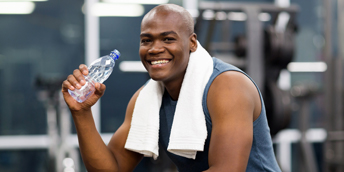
What you eat both before, during and after exercise affects your performance as well as recovery. Try these tips for pre and post workouts, in order to get the most out of your efforts.
Before Exercise Nutrition
What you eat before a workout, practice or game can affect your performance. Avoid high fat foods that are hard to digest. Try new foods on practice days, not game days, to make sure your body is able to adjust to the change without making you feel too full. Always remember to hydrate with water before the sweating starts, to avoid dehydration.
Choose from the options listed below at least 3 to 4 hours before a workout, practice or game. This will help to fuel your body with lasting energy.
What to eat before exercise:
- 2 to 3 large glasses of water AND any one of the following:
- Turkey and cheese sandwich on whole wheat bread with a piece of fruit, or
- Whole wheat toast with peanut butter and a glass of low-fat milk, or
- Low-fast granola and a fruit smoothie made with yogurt, or
- Oatmeal made with skim milk with fruit and nuts mixed in, or
- Low-fat cottage cheese with grapes and crackers
During Exercise Nutrition
Whether you are participating in an event or training for it, nutrition and hydration are important. Think of them as refueling your brain and muscles, so that you can reach peak performance. Remember, dehydration is a gradual process and its effects are not always felt immediately. As fluid is lost through perspiration, temperatures continue to rise as does your heart rate, leading to impaired skills and performance, particularly in hot weather.
Additionally, for athletes who perform and/or train for more than 90 minutes, carbohydrate intake during these times is known to improve performance. About 50 grams of carbs per hour and consistent fluid intake of 8 to 16 ounces of water, is generally recommended for prolonged events. These recommendations should be taken in small increments to avoid gastric upset, and studies show that 20 minute intervals seem to work best. Juices and sports drinks should be no more than 6 to 8% carbohydrate, as more concentration can actually impede performance. Remember that successful strategies are individual, and top athletes use training periods to understand exactly what their specific needs are.
Snacks with 50+ grams of carbohydrates include:
- 750 ml of a sports drink
- 500 ml of fruit juice or three small pieces of fruit
- 50 gram packet of jelly beans
- Breakfast or sports bars that can be broken into small servings during events and training
- Honey or jelly sandwich in small servings
- 2 sports gels
After Exercise Nutrition
Refueling your body after a workout, practice or game is just as important as what you put in your body before. You need to replace all the fluid you lose while sweating, and you need to refuel your muscles to make sure they are ready for your next workout. If your workout was intense, you may also need to replace electrolytes you lost through sweating with a sports drink that is low on sugar. Follow the fluid guidelines below to make the right choice. Choose any of the options below about 30 to 45 minutes after you finish exercising, to refuel and repair your muscles with the proper amounts of carbohydrates and protein.
What to drink/eat after exercise:
- If you exercised less than 1 hour, drink 2 to 3 large glasses of water to replace the fluid you have lost
- If you exercised for more than 1 hour, drink a low-sugar sports drink to replace the fluid and electrolytes your body has lost. Never choose caffeinated energy drinks; these can make you jittery and they have other negative side effects
- 8 to 12 oz. low-fat chocolate milk
- 8 oz. low-fat Greek yogurt
- Apple slices with peanut butter
- Carrot sticks with hummus
- Sports bar containing both protein and carbohydrates
Myth Buster: While a lot of people believe that you need to consume more than normal amounts of protein after a workout, that is usually not the case. An equal ratio of carbohydrates and protein is needed